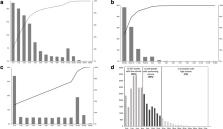- Record: found
- Abstract: found
- Article: found
Quality indicators for blood culture: 1 year of monitoring with BacT/Alert Virtuo at a French hospital

Read this article at
Abstract
Introduction
Blood culture (BC) remains the gold standard for the diagnosis of bloodstream infection. Clinical microbiology laboratories must ensure the quality of their BC process from receipt to definitive results.
Aim
In this study, we followed the evolution of different quality indicators for BCs over the first year of implementation of the BacT/Alert Virtuo system in a French hospital.
Methodology
In our laboratory, we instituted regular monitoring of several quality indicators to track (i) delays in sample registration, (ii) delays in loading BC bottles in our incubating system (BacT/Alert Virtuo) after registration, (iii) the volume of blood in bottles and (iv) the contamination rates.
Results
For 53 892 BC bottles loaded in the BacT/Alert Virtuo from 23 January to 31 December 2019, the delays in sample registration, loading and unloading were respectively 3.5 h±0.016, 44 min±0.209 and 5.8 h±0.0727. Intriguingly, the automated process performed by the BacT/Alert Virtuo system to check the blood volume in bottles was only performed for 60 % of the loaded bottles. Among these, 30 % contained the recommended volume of blood (between 7 and 13 ml). Finally, the contamination rate was found to be 27.2 % for samples at our institution.
Conclusions
The delays in sample registration, loading and unloading were found to be acceptable, even though they could be improved by ensuring a continuous service during the night duty period. Furthermore, the percentage of volumes measured is insufficient and must be improved and the majority of bottles do not contain the recommended blood volume.
Related collections
Most cited references14
- Record: found
- Abstract: found
- Article: not found
Overall burden of bloodstream infection and nosocomial bloodstream infection in North America and Europe.
- Record: found
- Abstract: found
- Article: not found
The clinical and prognostic importance of positive blood cultures in adults.
- Record: found
- Abstract: found
- Article: not found